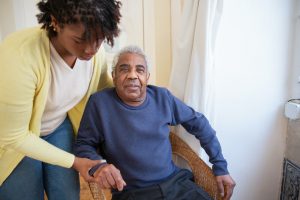In conventional mortgages, borrowers need to make regular monthly payments to steadily reduce the balance of their loan. Failure to make these monthly payments will allow the lender to declare the borrower in default and therefore reverse mortgage foreclosure. The foreclosed property is then sold by the lender, who must then use the proceeds of the sale to repay the balance of the loan.
On the other hand, in reverse mortgages, borrowers do not need to make regular monthly payments. Instead, the full amount of the loan is typically repaid when:
- the borrower dies;
- the borrower sells the mortgaged property;
- the borrower decides to move out the reverse mortgaged property or ceases to use the property as his principal residence; and
- the borrower fails to comply with the ongoing requirements of the reverse mortgage.
Since the term of the reverse mortgage loan depends on the occurrence of certain conditions, it is impossible to say with absolute certainty how long you can stay in your house with a reverse mortgage. However, assuming that you consistently comply with the ongoing requirements of the reverse mortgage, do not sell your house, and do not stop using it as your principal residence, and other conditions that do not trigger reverse mortgage default, then we can get a rough estimate of how long you can enjoy your reverse mortgage by examining the average American lifespan and the minimum age requirement for reverse mortgage borrowers.
According to an article published in the National Vital Statistics Reports (NVSS), made publicly available on the Centers for Disease Control and Prevention (CDC) website, the average American lifespan is 78.6 years. Women tend to live a few years longer than men, each with an average lifespan of 81.1 years and 76.1 years, respectively. Between ethnicities, Hispanics tend to live the longest (81.8 years); blacks the shortest (75.3 years); and whites somewhere along the middle (78.8 years).
Now, to be eligible for a reverse mortgage, you have to be at least 62 years old; using the mortgaged property as your primary residence (in other words, secondary homes or investment properties do not qualify for reverse mortgages); and pass the financial assessment check (which determines whether you are financially capable of satisfying the ongoing requirements of the reverse mortgage, such as the ability to keep paying with property taxes and homeowner’s insurance premiums, and to keep the mortgage in reasonably good condition).
If you are 62 years old when you take out your reverse mortgage (i.e. the minimum age for eligibility) and we assume that you are blessed with an average American lifespan of 78.6 years, then you can stay in your house with a reverse mortgage for a little over 16 years – again, this is assuming that you do not trigger any of the other events which shorten the term of the loan.
In conventional mortgages, borrowers need to make regular monthly payments to steadily reduce the balance of their loan. Failure to make these monthly payments will allow the lender to declare the borrower in default and therefore reverse mortgage foreclosure. The foreclosed property is then sold by the lender, who must then use the proceeds of the sale to repay the balance of the loan.
On the other hand, in reverse mortgages, borrowers do not need to make regular monthly payments. Instead, the full amount of the loan is typically repaid when:
- the borrower dies;
- the borrower sells the mortgaged property;
- the borrower decides to move out the property or ceases to use the property as his principal residence; and
- the borrower fails to comply with the ongoing requirements of the reverse mortgage.
Since the term of the reverse mortgage loan depends on the occurrence of certain conditions, it is impossible to say with absolute certainty how long you can stay in your house with a reverse mortgage. However, assuming that you consistently comply with the ongoing requirements of the reverse mortgage, do not sell your house, and do not stop using it as your principal residence, then we can get a rough estimate of how long you can enjoy your reverse mortgage by examining the average American lifespan and the minimum age requirement for reverse mortgage borrowers.
According to an article published in the National Vital Statistics Reports (NVSS), made publicly available on the Centers for Disease Control and Prevention (CDC) website, the average American lifespan is 78.6 years. Women tend to live a few years longer than men, each with an average lifespan of 81.1 years and 76.1 years, respectively. Between ethnicities, Hispanics tend to live the longest (81.8 years); blacks the shortest (75.3 years); and whites somewhere along the middle (78.8 years).
Now, to be eligible for a reverse mortgage, you have to be at least 62 years old; using the mortgaged property as your primary residence (in other words, secondary homes or investment properties do not qualify for reverse mortgages); and pass the financial assessment check (which determines whether you are financially capable of satisfying the ongoing requirements of the reverse mortgage, such as the ability to keep paying with property taxes and homeowner’s insurance premiums, and to keep the mortgage in reasonably good condition).
If you are 62 years old when you take out your reverse mortgage (i.e. the minimum age for eligibility) and we assume that you are blessed with an average American lifespan of 78.6 years, then you can stay in your house with a reverse mortgage for a little over 16 years – again, this is assuming that you do not trigger any of the other events which shorten the term of the loan.
What causes reverse mortgage defaults?
One of the main causes for default seems to be the fact that some reverse mortgage borrowers rely solely on their home equity and do not have any other substantial retirement assets to fall back on. Having nothing else to fall back to will increase your chance of defaulting on the reverse mortgage, especially when unexpected expenses suddenly arise, such as the numerous medical issues which you may develop as you age.
Another possible reason for the default is that some borrowers take out a reverse mortgage for the wrong reasons. Instead of using their reverse mortgage for the purpose in which it was intended (to allow senior citizens with limited income to tap into their home equity so that they may age comfortably in place), they use the proceeds of the loan to cover short-term financial needs.
Fortunately, since the Federal Housing Administration (FHA) started requiring a financial assessment of prospective borrowers on March 2, 2015, the number of defaulting reverse mortgage borrowers seems to have lessened significantly.
Moreover, prospective borrowers are also required to take a mandatory counseling course, the purpose of which is to thoroughly explain the concept behind reverse mortgages, its financial consequences, associated costs, payment options, and other important matters. In the end, the intention behind mandatory counseling is to allow prospective borrowers to determine for themselves if taking out a reverse mortgage is their best option to achieve their immediate and long-term goals.
All of the aforementioned safeguards have made a positive impact on the reverse mortgage industry, lessening the number of defaults, ensuring that borrowers get the most out of the reverse mortgages, and minimizing the potential risks of lenders and their underwriters.
Can your spouse continue living in the mortgaged property after you die?
Again, while the general rule is that reverse mortgages need to be paid off when the borrower dies, there are two relatively common exceptions:
- when there is a surviving spouse who continues living in the mortgaged property and continues to comply with the other requirements of the reverse mortgage; and
- when there is an eligible non-borrowing spouse.
Let us get the first exception out of the way now since the reason behind it is simple. It is pretty obvious that a reverse mortgage would continue if only one of the borrowers die and the surviving co-borrower continues to comply with the terms and conditions of the reverse mortgage. In this situation, there are effectively two borrowers, so it is only natural for the reverse mortgage to continue while one of them is still alive.
With that said, let us move on to the second exception, which is a bit more complicated. As you will discover, the requirements for a non-borrowing spouse to be able to continue the reverse mortgage are rather complicated. Thus, you may want to consult an attorney, counselor, or some other reverse mortgage expert so that they can carefully consider the unique circumstances of your case.
When you take out a reverse mortgage, a unique case number is assigned to your loan documents.
If your case number was assigned on or after August 4, 2014, payment of the loan will be deferred and the non-borrowing spouse will be allowed to stay in the mortgaged property, provided that the non-borrowing spouse is able to prove the following:
- That they either have legal title to the mortgaged property or have the right to reside in the same for life. Proof of this must be sent to the lender within 90 days from the date of the borrower’s death.
- That they were married to the borrowing spouse when the reverse mortgage was taken out, i.e. at the time the loan documents were signed and remained married to him at the time of his death. This rule is a bit different for same sex couples who were in a committed relationship at the time the loan documents were signed. Since these couples may have been unable to marry at this time, they need only show that they were married at the time of death.
- That they were named as an “Eligible Non-Borrowing Spouse” in the loan documents at the time in which they were signed. If you failed to identify your spouse as an Eligible Non-Borrowing Spouse on the loan documents, then you may need to seek legal assistance as soon as possible. It is likely that you will have to refinance and take out a new reverse mortgage. However, in order to qualify for refinancing, you will need to have enough leftover equity in your home. As mentioned, it would be better to seek expert advice if you find yourself in this situation, so that you can better evaluate all your options.
- That they were residing in the mortgaged property at the time the loan documents were signed up to the present.
- That they are willing and able to fulfill the ongoing requirements of the reverse mortgage, i.e. the timely payment of property taxes and insurance premiums, and the good maintenance of the mortgaged property.
On the other hand, if your case number was assigned before August 4, 2014, the non-borrowing spouse may continue to reside in the mortgaged property at the lender’s discretion. Upon the death of the borrowing spouse, the lender may choose to either foreclose the mortgage, as provided for in the reverse mortgage contract, or allow the non-borrowing spouse to stay after going through the Mortgagee Optional Election (MOE) Assignment.
To be eligible for MOE Assignment, the non-borrowing spouse must prove the following:
- That they were married to the borrowing spouse when the reverse mortgage was taken out, i.e. at the time the loan documents were signed, and remained married to him at the time of his death. This rule is a bit different for same sex couples who were in a committed relationship at the time the loan documents were signed. Since these couples may have been unable to marry at this time, they need only show that they were married at the time of death.
- That they were residing in the mortgaged property at the time the loan documents were signed up to the present.
They will also need to provide the lender with her Tax Identification Number or Social Security Number and certify the following on an annual basis:
- That they will no longer receive payments from the loan.
- That they are willing and able to fulfill the ongoing requirements of the reverse mortgage, i.e. the timely payment of property taxes and insurance premiums, and the good maintenance of the mortgaged property.
- That they will not sell the mortgaged property, transfer her principal residence, or perform any other act or omission that will make the reverse mortgage loan due and demandable.
What happens when you default on a reverse mortgage?
As discussed earlier, some borrowers default on reverse mortgage loans for a variety of reasons. When default sets in, the lender will send you a notice of default prior to any foreclosure proceedings. If you receive this notice, you will need to act quickly to remedy the cause of default. Any delays could result in the untimely foreclosure of the property.
If the reason for default is your failure to pay property taxes, then do so right away. If you cannot afford to do so, then you should seek expert advice from your reverse mortgage counselor or attorney. Some states or private organizations may offer assistance programs to help you with the tax delinquency.
On the other hand, if the reason for the default is your failure to keep the mortgaged property in good condition, then ask the lender to provide you with a written list of required repairs. If you can afford to have these repairs done, then do so right away. Otherwise, please seek expert advice for other possible options.
Finally, if the reason for the default is your alleged failure to use the property as a principal residence and you have good grounds to contest such findings, please seek expert advice immediately. You may be required to provide evidence to counter the lender’s findings, such as documents that show that your continued residence within the last 12 months.




